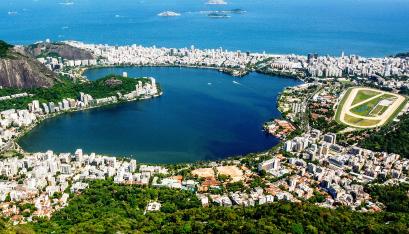Call and Book Your Hotel Now!
Domestic Toll-Free for US and Canada: 1-800-997-1438
Worldwide: +1-817-983-0682

Rio de Janeiro is distinguished by its remarkable diversity, contributing to its exceptional beauty. While primarily a metropolitan city, Rio has evolved amidst the Tijuca Forest, recognised as the largest urban forest globally.
Rio de Janeiro is positioned near the Tropic of Capricorn, situated on the far western stretch of Brazil's Atlantic coast. Serving as the capital of the Rio de Janeiro state in the southeastern region of Brazil, the city was established on an inlet of Guanabara Bay (Baía de Guanabara), marked by the iconic Sugar Loaf (Pão de Açúcar) at its entrance. To the south lies the Atlantic Ocean, while the western side is bordered by Sepetiba Bay (Baía de Sepetiba).
The city's Centre (Centro) is on the plains along the western shore of Guanabara Bay. The North Zone (Zona Norte) extends northwest on plains, encompassing marine and continental sediments as well as rocky mountains. The South Zone (Zona Sul) is separated from the Centre and the North Zone by coastal mountains.
Covering an area of 1,221 sq.km. (486.5 sq.mi.), the Rio de Janeiro municipality is part of the larger Metro region, spanning 4,539.8 sq.km. (1,759.6 sq.mi.). The Cabuçu or Piraquê is the primary river in Rio, and notable islands include Laje, Villegaignon, Cobras, Fiscal, Enxadas in Guanabara Bay, Cotunduba, Arquipélago das Cagarras, Rasa, Arquipélago da Redonda, Arquipélago das Tijucas, Palmas e Peças, and Frade in the Atlantic Ocean, as well as Bom Jardim, Nova, Cavado, Guaraquessaba, Tatu, Pescaria in Sepetiba Bay. The region also features picturesque lagoons like Jacarepaguá Lagoon, Marapendi Lagoon, Lagoinha, and Rodrigo de Freitas Lagoon, offering scenic surroundings with excellent amenities for outdoor activities. Rio's extensive coastline measures 246.22 km (153 miles), encompassing Guanabara Bay, the Atlantic Ocean, and Sepetiba Bay.

Rio de Janeiro experiences a tropical savanna climate characterised by humid, hot summers and warm, sunny winters. In the inland areas, temperatures can occasionally reach 40°C (104°F), typically hovering around 30°C (86°F). Coastal regions, influenced by ocean winds, tend to be somewhat cooler. Summer brings heavy rains, sometimes causing floods, but the rapid and intense evening rains provide relief from the heat. Due to its geographic location, Rio is prone to cold fronts from Antarctica during autumn and winter. The mountainous areas receive higher rainfall, acting as a barrier to humid winds from the Atlantic.